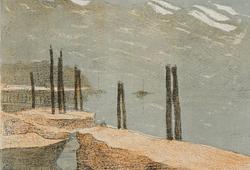Lena Cronqvist
"Grimaser, mun"
Signed Lena Cronqvist and numbered 4/4. Executed in 1998. Bronze. Height 98, width 75 cm, depth 42 cm. Foundry mark from Empire Bronze, New York.
Provenance
Lars Bohman Gallery, Stockholm.
Literature
Mårten Castenfors and Louise Fogelström, Liljevalchs, "Lena Cronqvist", 2014, exhibition catalogue Liljevalchs, pictured on p. 73.
More information
In the 1990s, Lena Cronqvist began to seriously explore sculpture as a form of expression, and in the last decade she has increasingly emerged as one of the most intriguing sculptors in the world today. The early sculptures, some of which were created during visits to New York with husband and author Göran Tunström, were small in size. In the opening remarks toLena Cronqvist’s exhibition catalogue for the exhibition at Konsthallen Lokstallet in Strömstad in 2000. Göran Tunström described the first “Girls” this way:
“I remember them backlit, in our first, cramped apartment in New York, those little wax clumps. How they were transformed - as if she could see through her fingers - into creatures with an appearance, character, little ugly-pretty figures in the beginning stages of life, with the whole registry of possible actions in their genes. And they were smiling. They smile, they stick out their tongue, they place their hands precociously on their hips and do not behave appropriately at all. They giggle at themselves and at us. And surely they have Names, though they currently do not disclose them, because a Name would lock them out of the utopian country where every action - even the most cruel ones - is allowed, every grimace a challenge, both to the world and to the SELF that they (we) have been domesticated to bear, very soon when it has abruptly ended, the era of the Girl. Of the child.”
Mårten Castenfors and Louise Fogelström describe, in the Liljevalchs’ exhibition catalogue “Lena Cronqvist”, 2014, how the artist works in parallel with painting and sculpture while in New York. “Picked out of their paintings, the girls are alive in tubs and in water. The sculptures are teasingly distinctive, and their wit calls to mind the sculptures Matisse once made – he too a wonderful painter who, through clay, went one step further as an artist. "
Artist
Lena Cronqvist is born and raised in Karlstad. Her interest for the arts came early in her life, and she spent the first year of her studies in England, near Bristol’s Art School. Upon her arrival back in Sweden, Cronqvist began a short-lived education at Konstfack, leaving to study painting at the Royal Academy of Fine Arts. When examining Lena Cronqvist's painting, it delves into "painting" in its more traditional sense. She is indeed a painter in the grand modern tradition, frequently turning to Edvard Munch and Francis Bacon’s art as inspirational sources. Yet she also had numerous art historical references and a deep love for the craft. Cronqvist excelled as a colourist, finding harmony in the most unusual colour combinations – few have managed to paint warmth and cold successfully at the same time. Her subject matter is often perceived as challenging and overly private by many. She often models herself for her art, posing in mundane situations imbued with a sharp psychological character. Her “Modonna-pictures” from the 1970s are a good example of this. She turns our gaze away from the conventional, notably in her portrayal and depiction of girls, which is fascinating. Cronqvist depicts these girls as ugly, simple, and altogether uncomfortable – a great contrast to how woman were normally portrayed in art. In more recent years, Lena Cronqvist has studied the effect of aging, using herself as a study. Moreover, Cronqvist is a very successful sculptor, and several of her works in bronze have been sold great sums in the auction world. She is also gifted in graphic productions, of which “Strindbergsmappen” is the most well-known. Among her most renowned works is "The Betrothal," a paraphrase of Jan van Eyck's symbol-laden painting "The Arnolfini Portrait." In Cronqvist's reinterpretation, artist and husband Göran Tunström are the main characters, with equally weighty symbolism but carrying entirely different meanings. Where van Eyck's painting features a loyal dog, Cronqvist replaces it with a cat—a symbol of independence.
Read more


















































